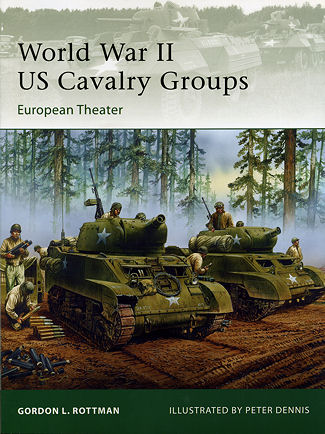 With
most nations, WWII spelled the end of horse cavalry. Sure, there was some use of
the horse cavalry early in the war, but it was soon realized that it was an
anachronism and those units that called themselves cavalry turned into motorized
units.
With
most nations, WWII spelled the end of horse cavalry. Sure, there was some use of
the horse cavalry early in the war, but it was soon realized that it was an
anachronism and those units that called themselves cavalry turned into motorized
units.
In the US, this meant armored cars, jeeps and
motorcycles. It also meant reorganization of units, something that was
eventually seen to have not been needed as many units lost a lot of history with
the renaming and renumbering. The switch to motorized was relatively smooth and
US units destined for Europe were able to get in a lot of practice prior to
deployment. This not only meant local exercises, but those at other bases in
other parts of the country. This allowed the units to get use to rail deployment
as well as operating on terrain that was not available locally. Even when they
arrived in the UK, the training continued so those units that entered France in
July 1944 were very much ready to go.
This is where things sort of fell apart. You see,
cavalry was not intended to be a mass attacking force like the infantry. They
were designed mostly for reconnaissance and not to be involved in sustained
combat. They had insufficient medical support, insufficient supply, minimal
trucks, no artillery, no proper AFVs. Their vehicles were lightly armored and
easily destroyed. Even the M8 howitzers and M5 tanks were unable to defeat most
obstacles. Yet that is how these units were often used. These units were able to
eventually either overcome the obstacles placed in their path, or lead a
coordinated retreat to where assets were available.
Post war, many of these units were used in as
security police and some stayed in Germany until 1952. Many of these units were
also National Guard and after the war, were quickly returned to state control.
In this book, author Gordon Rottman takes a look at
the changes and organization of US cavalry units in the early 1940s. He has a
look at their training and the equipment they used before and during the war.
There is a complete section that offers some of the more memorable exploits of
various units as they fought after D-day. We also have a look at what was
learned from the experiences of combat in Europe. All of this is superbly
illustrated by period photo and by the excellent artwork of Peter Dennis, one of
Osprey's best illustrators. This includes not only battle scenes but also well
illustrated organizational charts.
It all makes for a book that is very well done and
quite interesting. If you are interested in these units or are a modeler who
wants more insight into the subject, then this is a book for you.
November 2012
For more on the complete line of Osprey books,
visit www.ospreypublishing.com. In the US, it is
Osprey Direct at 443 Park Avenue South, New York, NY 10016, where you can
get a catalogue of available books.
If you would like your product reviewed fairly and
fairly quickly, please contact
the editor or see other details in the Note to
Contributors.
 With
most nations, WWII spelled the end of horse cavalry. Sure, there was some use of
the horse cavalry early in the war, but it was soon realized that it was an
anachronism and those units that called themselves cavalry turned into motorized
units.
With
most nations, WWII spelled the end of horse cavalry. Sure, there was some use of
the horse cavalry early in the war, but it was soon realized that it was an
anachronism and those units that called themselves cavalry turned into motorized
units.